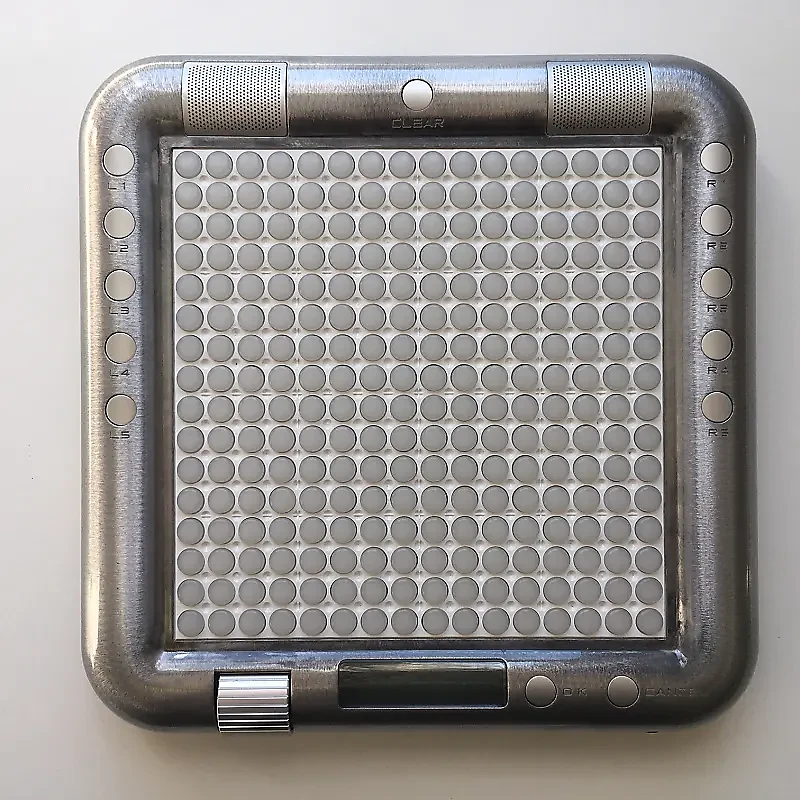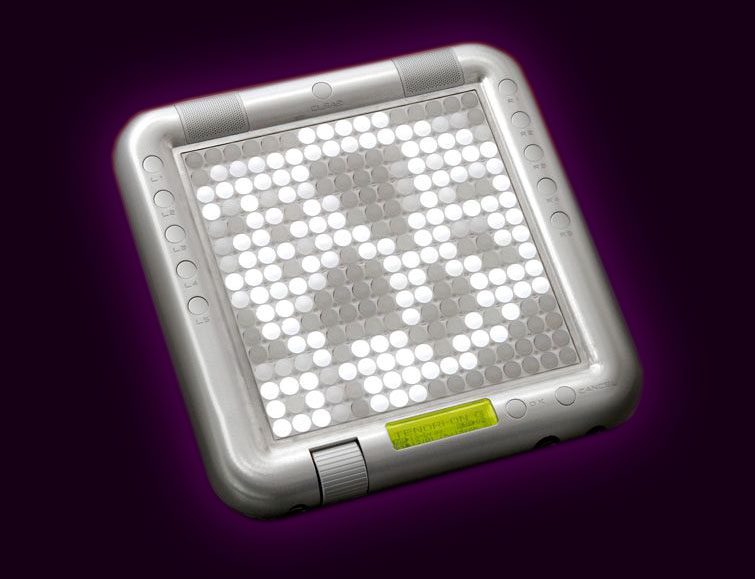Tenori-on
Electronic Instruments
Asia
Between 1901 and present
Video
The Tenori-on is an innovative digital musical instrument designed to merge visual and auditory creativity. Developed by Toshio Iwai, a Japanese media artist, in collaboration with Yamaha, the Tenori-on is a grid-based electronic instrument that allows musicians to create complex musical compositions through an interactive LED interface.
Unlike traditional instruments that rely on physical strings, keys, or drums, the Tenori-on utilizes a 16×16 grid of LED buttons, where each press generates a corresponding musical note. This unique approach makes it not only a musical instrument but also an interactive visual experience, as the LED lights display dynamic patterns in sync with the music. The Tenori-on is primarily used in electronic music, and its intuitive design allows both professional musicians and beginners to experiment with musical compositions. Unlike conventional synthesizers or drum machines, the Tenori-on encourages improvisation and live performance, making it a highly versatile tool for modern music production. Due to its distinct features and design, it has gained popularity among experimental musicians and electronic artists worldwide.
History and Origin of Tenori-on
The Tenori-on originated in Japan in the early 21st century. Its development was influenced by the advancements in digital music technology and the increasing integration of interactive visuals into musical performances. The concept of the instrument was conceived by Toshio Iwai, who had previously worked on various digital art projects and interactive installations. Inspired by the relationship between sound and light, Iwai envisioned a device that would allow users to compose music visually while interacting with illuminated buttons.
The Tenori-on was officially released in 2007 by Yamaha, a company well-known for its contributions to musical instrument innovation. While the instrument is digital and does not have roots in any specific classical or folk tradition, it represents a significant milestone in the evolution of electronic music instruments. It was designed to be accessible to both professional musicians and casual users, allowing them to create music in an entirely new way.
Unlike traditional musical instruments that evolved over centuries, the Tenori-on is a product of modern technological advancements. However, it shares some conceptual similarities with older electronic instruments such as the sequencer and drum machine, which also allow users to program and manipulate musical patterns. Since its release, the Tenori-on has been embraced by experimental artists and has been used in various genres, from ambient and electronic music to contemporary compositions.
Types and Features of Tenori-on
Although the Tenori-on follows a standard design, there are a few variations in its models that cater to different users. The most notable versions are the original Tenori-on (TNR-W) and the more affordable TNR-O. Both models offer the same core functionality but differ in their materials and LED display quality.
Construction and Material
The Tenori-on features a 16×16 grid of LED buttons, which serve as both input and output. The original Tenori-on (TNR-W) is housed in a magnesium frame with LEDs on both the front and back, making it visually appealing during live performances. The TNR-O, on the other hand, has a plastic body with LEDs only on the front, making it more cost-effective but less visually striking.
Each button on the grid represents a note, and the position of the button determines pitch and timing. The instrument includes built-in speakers, as well as MIDI and audio output options, allowing users to connect it to external sound systems or digital workstations. The buttons are touch-sensitive, enabling users to control volume and dynamics based on how they interact with the grid.
Modes and Functionality
One of the key features of the Tenori-on is its multiple modes, which allow users to experiment with different ways of composing and performing music. These modes include:
Score Mode: Users can manually place notes on the grid, which then play back in a loop, similar to a sequencer.
Random Mode: The instrument generates random patterns based on user input, encouraging experimentation.
Bounce Mode: Notes behave like bouncing balls, triggering sounds as they move across the grid.
Draw Mode: Users can draw patterns directly on the grid, creating evolving soundscapes.
Layer Mode: The instrument allows multiple layers of sound to be played simultaneously, creating complex compositions.
The ability to switch between these modes in real time makes the Tenori-on a dynamic and expressive instrument, ideal for live performances and improvisational music creation.
Work Mechanics and Playing Technique
The Tenori-on operates on a simple yet powerful principle: users interact with a grid of LED buttons to create musical sequences. Each button press corresponds to a musical note, and the horizontal position of the button determines when the note is played in a looping sequence. The vertical position affects pitch, with higher positions producing higher-pitched notes.
Playing with Grid Interaction
Playing the Tenori-on involves touching or pressing the buttons on the LED grid. Musicians can create rhythms, melodies, and harmonies by placing notes at different positions on the grid. The instrument automatically loops these sequences, allowing users to layer sounds and develop complex compositions. Since it operates digitally, it provides real-time feedback, making it easy to experiment with different musical ideas.
MIDI and Sound Customization
The Tenori-on includes built-in sounds and samples, but it also supports MIDI connectivity, enabling users to control external synthesizers and sound modules. This expands its functionality, allowing musicians to integrate it with other electronic instruments. Additionally, users can import their own samples, giving them complete control over the sounds produced by the instrument.
Role in Music
The Tenori-on has played an important role in shaping modern electronic music. While it is not as widely used as traditional synthesizers or drum machines, it has carved out a niche in experimental and live performance music. The instrument’s grid-based approach to composition has influenced other digital instruments and software, including modern grid controllers like the Novation Launchpad. The Tenori-on has been used by various musicians across different genres. Some artists incorporate it into ambient and experimental music, using its visual interface to create evolving soundscapes. Others use it in dance and electronic music, where its looping capabilities allow for real-time improvisation during live performances. The instrument’s unique visual component also makes it popular for multimedia performances, where sound and visuals are integrated seamlessly.
Since its release, the Tenori-on has also been adopted by educators and music technology enthusiasts. Its intuitive interface makes it a valuable tool for teaching music composition and electronic music production. Many workshops and courses on digital music include the Tenori-on as a way to introduce students to sequencing, pattern-based composition, and interactive sound design.
Significance of the Tenori-on
The Tenori-on is significant not only as a musical instrument but also as an example of how technology can transform artistic expression. It represents a shift away from traditional musical instruments and introduces a more visual and tactile approach to music creation.
One of its most notable contributions is its ability to bridge the gap between music and digital art. Unlike traditional instruments that require years of practice to master, the Tenori-on allows users to create compelling compositions with minimal technical knowledge. This democratization of music-making aligns with the broader trend of electronic instruments becoming more accessible to the general public. Additionally, the Tenori-on has inspired other instruments and music software that use grid-based sequencing. Devices like the Ableton Push, Monome, and Novation Launchpad owe some of their design principles to the Tenori-on’s innovative approach. This influence demonstrates the lasting impact of the instrument on digital music production.
Despite its niche status, the Tenori-on remains a beloved instrument among experimental musicians, multimedia artists, and music enthusiasts. It continues to be used in performances and compositions that push the boundaries of electronic music. While newer technologies have emerged, the Tenori-on’s unique combination of sound and visuals ensures that it remains relevant in the world of digital music. The Tenori-on stands out as a pioneering digital musical instrument that combines sound and visual interaction in an unprecedented way. Developed in Japan and released in 2007, it has redefined how music can be composed and performed using a grid-based interface. Its multiple modes, intuitive design, and real-time looping capabilities make it a powerful tool for musicians of all levels.
While it may not have the historical depth of traditional acoustic instruments, the Tenori-on’s impact on electronic music and performance art is undeniable. It has influenced modern MIDI controllers and grid-based sequencers, leaving a lasting legacy in the world of digital music. Whether used for experimental sound design, live performances, or education, the Tenori-on continues to inspire creativity and innovation in the musical world.
FAQ
What is the origin of the Tenori-on?
The Tenori-on originates from Japan, designed by Toshio Iwai and Yu Nishibori in collaboration with Yamaha. It was first introduced in the early 21st century, specifically in 2007.
What historical context influenced the creation of the Tenori-on?
The Tenori-on was influenced by Toshio Iwai's earlier work, such as Electroplankton for the Nintendo DS, and his interest in interactive media and music. It reflects a shift towards more accessible and visually engaging electronic music instruments.
How does the Tenori-on contribute to music performance?
The Tenori-on contributes to music performance by providing a unique visual interface that enhances live shows. Its ability to control external synthesizers via MIDI expands its musical capabilities, making it a versatile tool for electronic musicians.
 Links
Links
References
 Similar
Similar
Instruments
Other Instrument
Categories



















